MREGC5001 - Asset Management: Design, Maintainability & Reliability
VerifiedAdded on 2023/04/08
|11
|1637
|369
Report
AI Summary
This report delves into asset management, maintainability, and reliability within an organizational context, emphasizing the importance of stakeholder expectations and the scope of maintenance organizations. It examines the role of maintenance managers and superintendents, highlighting the necessity of documented systems for effective maintenance management. The report further discusses risk-based maintenance management, the utilization of lifecycle costing (LCC) in decision-making, and the challenges faced by maintenance engineers, such as the lack of reliable databases, appropriate skills, and data sharing mechanisms. Ultimately, it concludes with opportunities for improvement in asset management, advocating for a focus on quality over quantity, comprehensive information sources, and improved data analysis to enhance the maintenance and operation of organizational assets. The report also includes calculations related to investment opportunities and maintenance metrics.
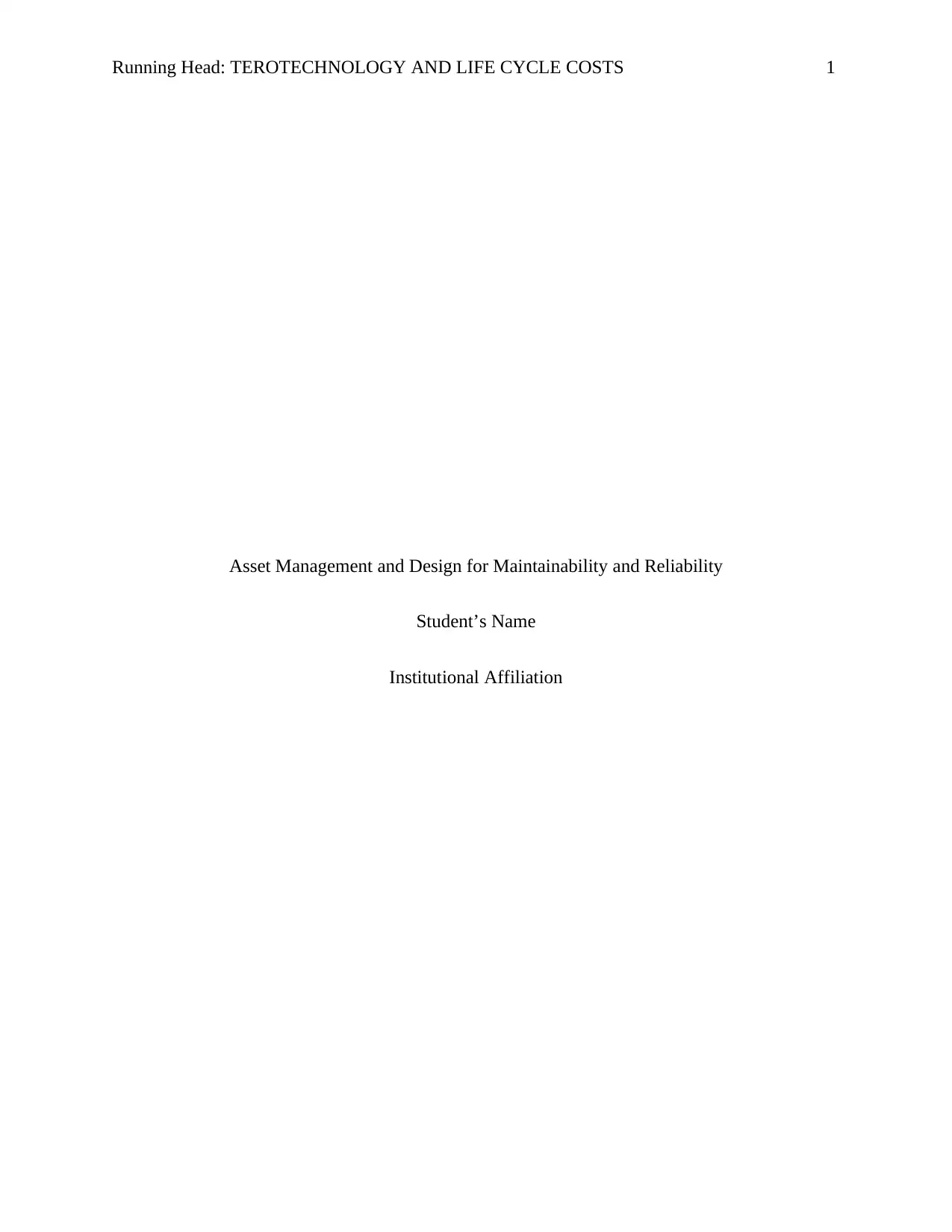
Running Head: TEROTECHNOLOGY AND LIFE CYCLE COSTS 1
Asset Management and Design for Maintainability and Reliability
Student’s Name
Institutional Affiliation
Asset Management and Design for Maintainability and Reliability
Student’s Name
Institutional Affiliation
Secure Best Marks with AI Grader
Need help grading? Try our AI Grader for instant feedback on your assignments.
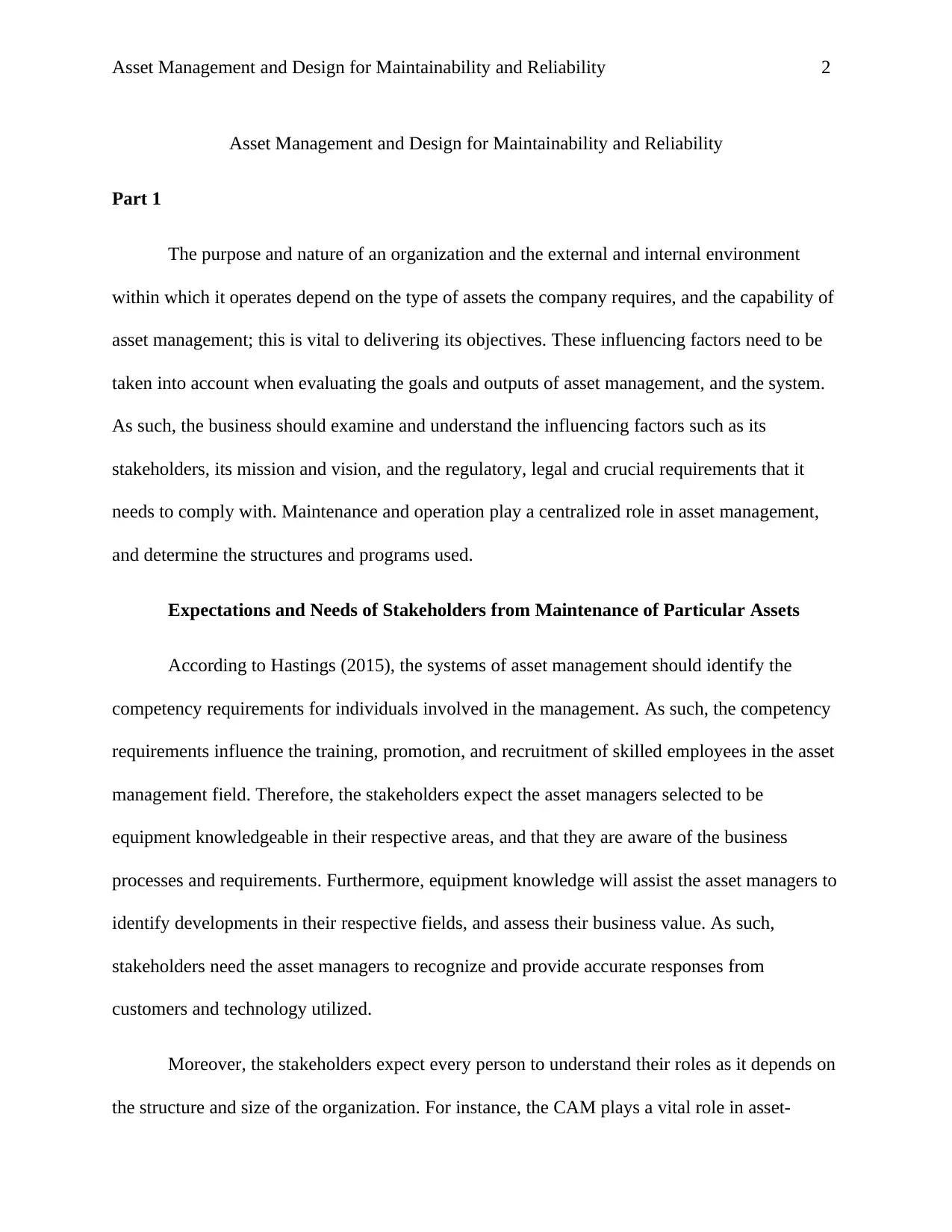
Asset Management and Design for Maintainability and Reliability 2
Asset Management and Design for Maintainability and Reliability
Part 1
The purpose and nature of an organization and the external and internal environment
within which it operates depend on the type of assets the company requires, and the capability of
asset management; this is vital to delivering its objectives. These influencing factors need to be
taken into account when evaluating the goals and outputs of asset management, and the system.
As such, the business should examine and understand the influencing factors such as its
stakeholders, its mission and vision, and the regulatory, legal and crucial requirements that it
needs to comply with. Maintenance and operation play a centralized role in asset management,
and determine the structures and programs used.
Expectations and Needs of Stakeholders from Maintenance of Particular Assets
According to Hastings (2015), the systems of asset management should identify the
competency requirements for individuals involved in the management. As such, the competency
requirements influence the training, promotion, and recruitment of skilled employees in the asset
management field. Therefore, the stakeholders expect the asset managers selected to be
equipment knowledgeable in their respective areas, and that they are aware of the business
processes and requirements. Furthermore, equipment knowledge will assist the asset managers to
identify developments in their respective fields, and assess their business value. As such,
stakeholders need the asset managers to recognize and provide accurate responses from
customers and technology utilized.
Moreover, the stakeholders expect every person to understand their roles as it depends on
the structure and size of the organization. For instance, the CAM plays a vital role in asset-
Asset Management and Design for Maintainability and Reliability
Part 1
The purpose and nature of an organization and the external and internal environment
within which it operates depend on the type of assets the company requires, and the capability of
asset management; this is vital to delivering its objectives. These influencing factors need to be
taken into account when evaluating the goals and outputs of asset management, and the system.
As such, the business should examine and understand the influencing factors such as its
stakeholders, its mission and vision, and the regulatory, legal and crucial requirements that it
needs to comply with. Maintenance and operation play a centralized role in asset management,
and determine the structures and programs used.
Expectations and Needs of Stakeholders from Maintenance of Particular Assets
According to Hastings (2015), the systems of asset management should identify the
competency requirements for individuals involved in the management. As such, the competency
requirements influence the training, promotion, and recruitment of skilled employees in the asset
management field. Therefore, the stakeholders expect the asset managers selected to be
equipment knowledgeable in their respective areas, and that they are aware of the business
processes and requirements. Furthermore, equipment knowledge will assist the asset managers to
identify developments in their respective fields, and assess their business value. As such,
stakeholders need the asset managers to recognize and provide accurate responses from
customers and technology utilized.
Moreover, the stakeholders expect every person to understand their roles as it depends on
the structure and size of the organization. For instance, the CAM plays a vital role in asset-
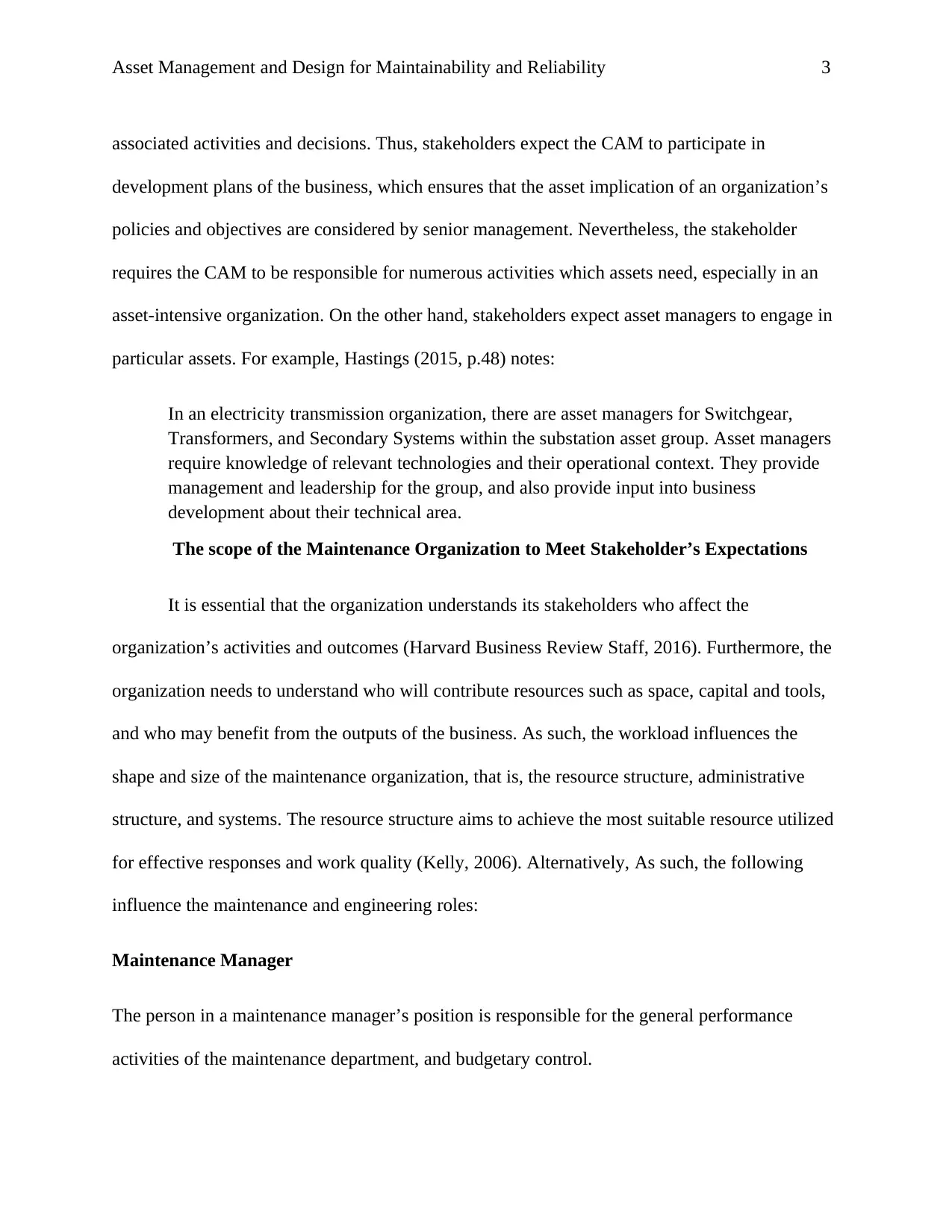
Asset Management and Design for Maintainability and Reliability 3
associated activities and decisions. Thus, stakeholders expect the CAM to participate in
development plans of the business, which ensures that the asset implication of an organization’s
policies and objectives are considered by senior management. Nevertheless, the stakeholder
requires the CAM to be responsible for numerous activities which assets need, especially in an
asset-intensive organization. On the other hand, stakeholders expect asset managers to engage in
particular assets. For example, Hastings (2015, p.48) notes:
In an electricity transmission organization, there are asset managers for Switchgear,
Transformers, and Secondary Systems within the substation asset group. Asset managers
require knowledge of relevant technologies and their operational context. They provide
management and leadership for the group, and also provide input into business
development about their technical area.
The scope of the Maintenance Organization to Meet Stakeholder’s Expectations
It is essential that the organization understands its stakeholders who affect the
organization’s activities and outcomes (Harvard Business Review Staff, 2016). Furthermore, the
organization needs to understand who will contribute resources such as space, capital and tools,
and who may benefit from the outputs of the business. As such, the workload influences the
shape and size of the maintenance organization, that is, the resource structure, administrative
structure, and systems. The resource structure aims to achieve the most suitable resource utilized
for effective responses and work quality (Kelly, 2006). Alternatively, As such, the following
influence the maintenance and engineering roles:
Maintenance Manager
The person in a maintenance manager’s position is responsible for the general performance
activities of the maintenance department, and budgetary control.
associated activities and decisions. Thus, stakeholders expect the CAM to participate in
development plans of the business, which ensures that the asset implication of an organization’s
policies and objectives are considered by senior management. Nevertheless, the stakeholder
requires the CAM to be responsible for numerous activities which assets need, especially in an
asset-intensive organization. On the other hand, stakeholders expect asset managers to engage in
particular assets. For example, Hastings (2015, p.48) notes:
In an electricity transmission organization, there are asset managers for Switchgear,
Transformers, and Secondary Systems within the substation asset group. Asset managers
require knowledge of relevant technologies and their operational context. They provide
management and leadership for the group, and also provide input into business
development about their technical area.
The scope of the Maintenance Organization to Meet Stakeholder’s Expectations
It is essential that the organization understands its stakeholders who affect the
organization’s activities and outcomes (Harvard Business Review Staff, 2016). Furthermore, the
organization needs to understand who will contribute resources such as space, capital and tools,
and who may benefit from the outputs of the business. As such, the workload influences the
shape and size of the maintenance organization, that is, the resource structure, administrative
structure, and systems. The resource structure aims to achieve the most suitable resource utilized
for effective responses and work quality (Kelly, 2006). Alternatively, As such, the following
influence the maintenance and engineering roles:
Maintenance Manager
The person in a maintenance manager’s position is responsible for the general performance
activities of the maintenance department, and budgetary control.
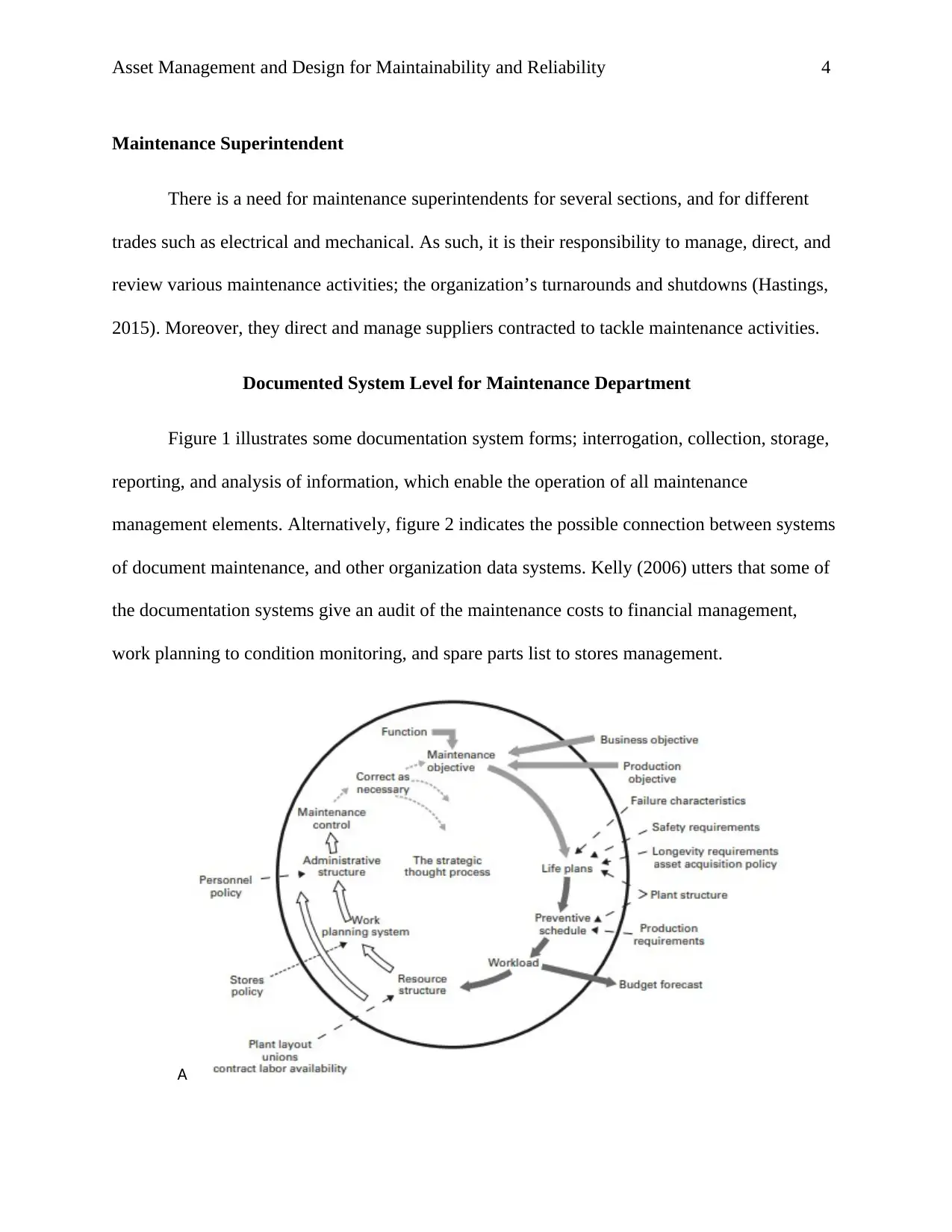
Asset Management and Design for Maintainability and Reliability 4
Maintenance Superintendent
There is a need for maintenance superintendents for several sections, and for different
trades such as electrical and mechanical. As such, it is their responsibility to manage, direct, and
review various maintenance activities; the organization’s turnarounds and shutdowns (Hastings,
2015). Moreover, they direct and manage suppliers contracted to tackle maintenance activities.
Documented System Level for Maintenance Department
Figure 1 illustrates some documentation system forms; interrogation, collection, storage,
reporting, and analysis of information, which enable the operation of all maintenance
management elements. Alternatively, figure 2 indicates the possible connection between systems
of document maintenance, and other organization data systems. Kelly (2006) utters that some of
the documentation systems give an audit of the maintenance costs to financial management,
work planning to condition monitoring, and spare parts list to stores management.
A
Maintenance Superintendent
There is a need for maintenance superintendents for several sections, and for different
trades such as electrical and mechanical. As such, it is their responsibility to manage, direct, and
review various maintenance activities; the organization’s turnarounds and shutdowns (Hastings,
2015). Moreover, they direct and manage suppliers contracted to tackle maintenance activities.
Documented System Level for Maintenance Department
Figure 1 illustrates some documentation system forms; interrogation, collection, storage,
reporting, and analysis of information, which enable the operation of all maintenance
management elements. Alternatively, figure 2 indicates the possible connection between systems
of document maintenance, and other organization data systems. Kelly (2006) utters that some of
the documentation systems give an audit of the maintenance costs to financial management,
work planning to condition monitoring, and spare parts list to stores management.
A
Secure Best Marks with AI Grader
Need help grading? Try our AI Grader for instant feedback on your assignments.
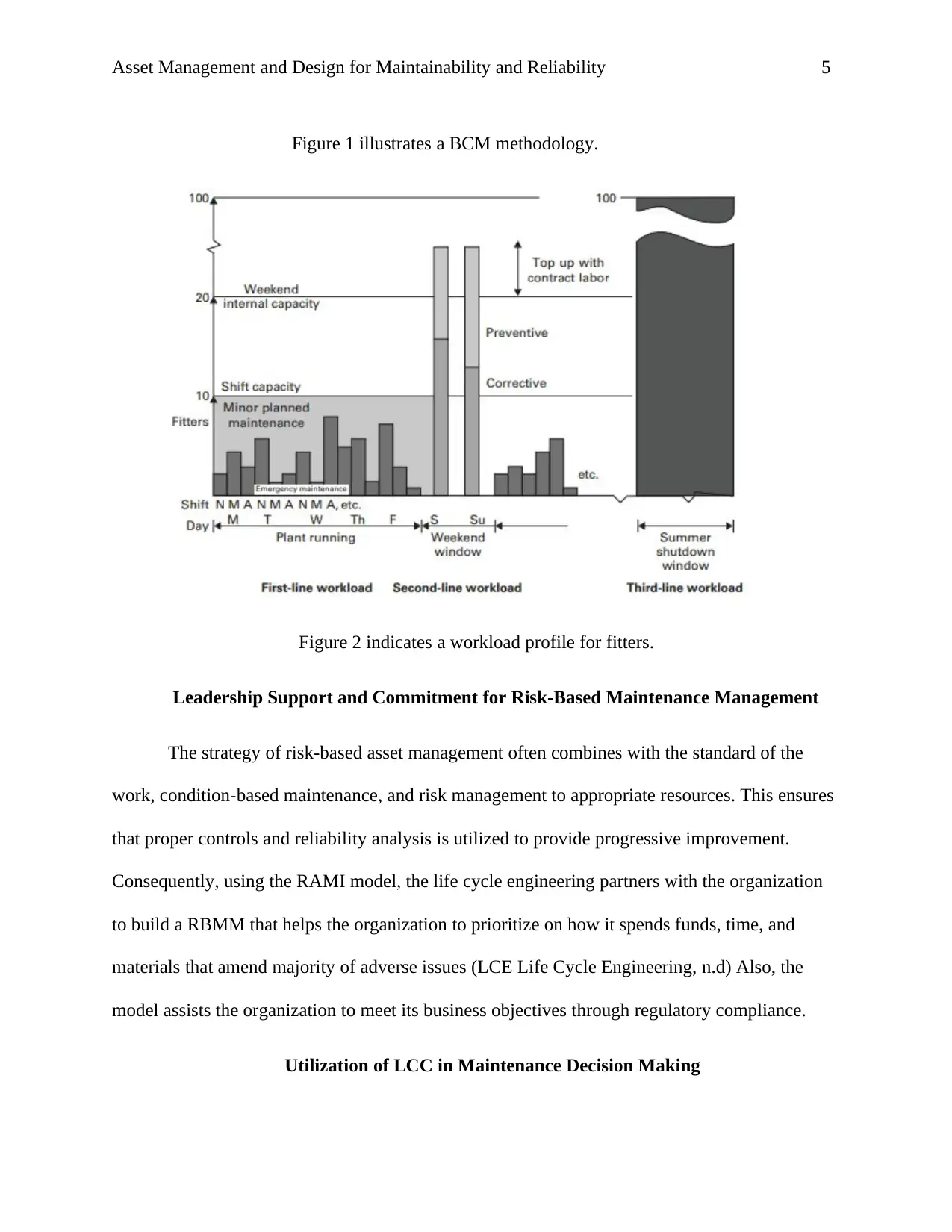
Asset Management and Design for Maintainability and Reliability 5
Figure 1 illustrates a BCM methodology.
Figure 2 indicates a workload profile for fitters.
Leadership Support and Commitment for Risk-Based Maintenance Management
The strategy of risk-based asset management often combines with the standard of the
work, condition-based maintenance, and risk management to appropriate resources. This ensures
that proper controls and reliability analysis is utilized to provide progressive improvement.
Consequently, using the RAMI model, the life cycle engineering partners with the organization
to build a RBMM that helps the organization to prioritize on how it spends funds, time, and
materials that amend majority of adverse issues (LCE Life Cycle Engineering, n.d) Also, the
model assists the organization to meet its business objectives through regulatory compliance.
Utilization of LCC in Maintenance Decision Making
Figure 1 illustrates a BCM methodology.
Figure 2 indicates a workload profile for fitters.
Leadership Support and Commitment for Risk-Based Maintenance Management
The strategy of risk-based asset management often combines with the standard of the
work, condition-based maintenance, and risk management to appropriate resources. This ensures
that proper controls and reliability analysis is utilized to provide progressive improvement.
Consequently, using the RAMI model, the life cycle engineering partners with the organization
to build a RBMM that helps the organization to prioritize on how it spends funds, time, and
materials that amend majority of adverse issues (LCE Life Cycle Engineering, n.d) Also, the
model assists the organization to meet its business objectives through regulatory compliance.
Utilization of LCC in Maintenance Decision Making
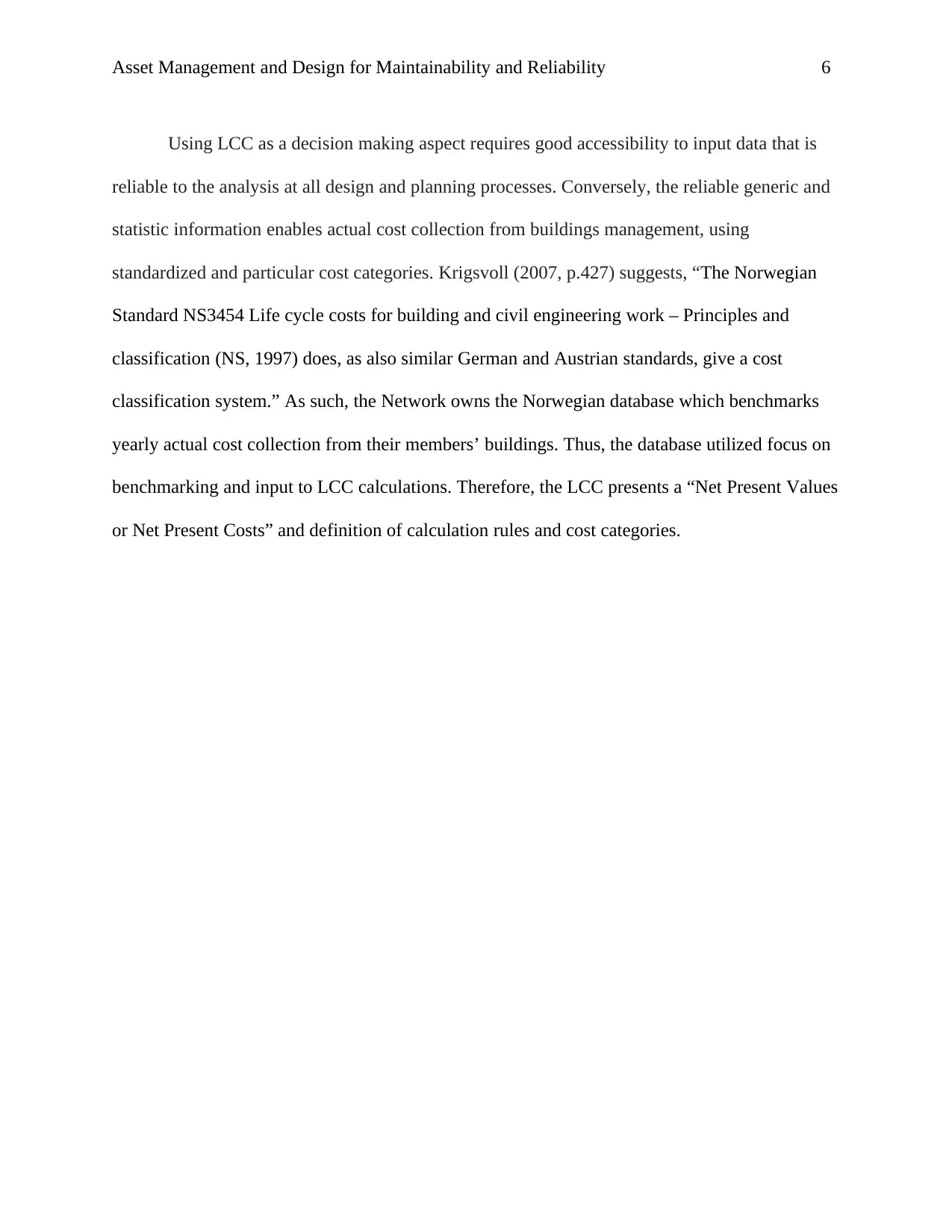
Asset Management and Design for Maintainability and Reliability 6
Using LCC as a decision making aspect requires good accessibility to input data that is
reliable to the analysis at all design and planning processes. Conversely, the reliable generic and
statistic information enables actual cost collection from buildings management, using
standardized and particular cost categories. Krigsvoll (2007, p.427) suggests, “The Norwegian
Standard NS3454 Life cycle costs for building and civil engineering work – Principles and
classification (NS, 1997) does, as also similar German and Austrian standards, give a cost
classification system.” As such, the Network owns the Norwegian database which benchmarks
yearly actual cost collection from their members’ buildings. Thus, the database utilized focus on
benchmarking and input to LCC calculations. Therefore, the LCC presents a “Net Present Values
or Net Present Costs” and definition of calculation rules and cost categories.
Using LCC as a decision making aspect requires good accessibility to input data that is
reliable to the analysis at all design and planning processes. Conversely, the reliable generic and
statistic information enables actual cost collection from buildings management, using
standardized and particular cost categories. Krigsvoll (2007, p.427) suggests, “The Norwegian
Standard NS3454 Life cycle costs for building and civil engineering work – Principles and
classification (NS, 1997) does, as also similar German and Austrian standards, give a cost
classification system.” As such, the Network owns the Norwegian database which benchmarks
yearly actual cost collection from their members’ buildings. Thus, the database utilized focus on
benchmarking and input to LCC calculations. Therefore, the LCC presents a “Net Present Values
or Net Present Costs” and definition of calculation rules and cost categories.
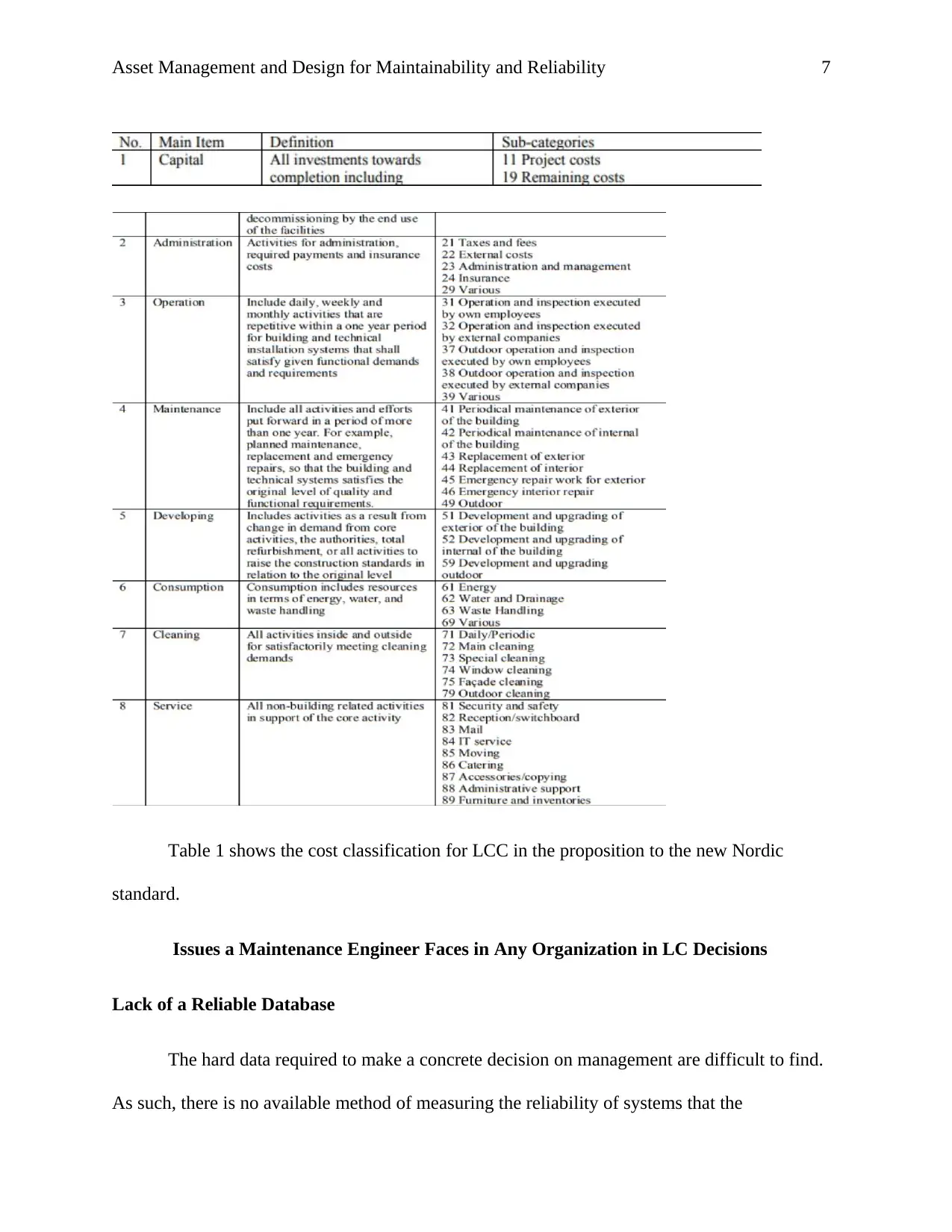
Asset Management and Design for Maintainability and Reliability 7
Table 1 shows the cost classification for LCC in the proposition to the new Nordic
standard.
Issues a Maintenance Engineer Faces in Any Organization in LC Decisions
Lack of a Reliable Database
The hard data required to make a concrete decision on management are difficult to find.
As such, there is no available method of measuring the reliability of systems that the
Table 1 shows the cost classification for LCC in the proposition to the new Nordic
standard.
Issues a Maintenance Engineer Faces in Any Organization in LC Decisions
Lack of a Reliable Database
The hard data required to make a concrete decision on management are difficult to find.
As such, there is no available method of measuring the reliability of systems that the
Paraphrase This Document
Need a fresh take? Get an instant paraphrase of this document with our AI Paraphraser
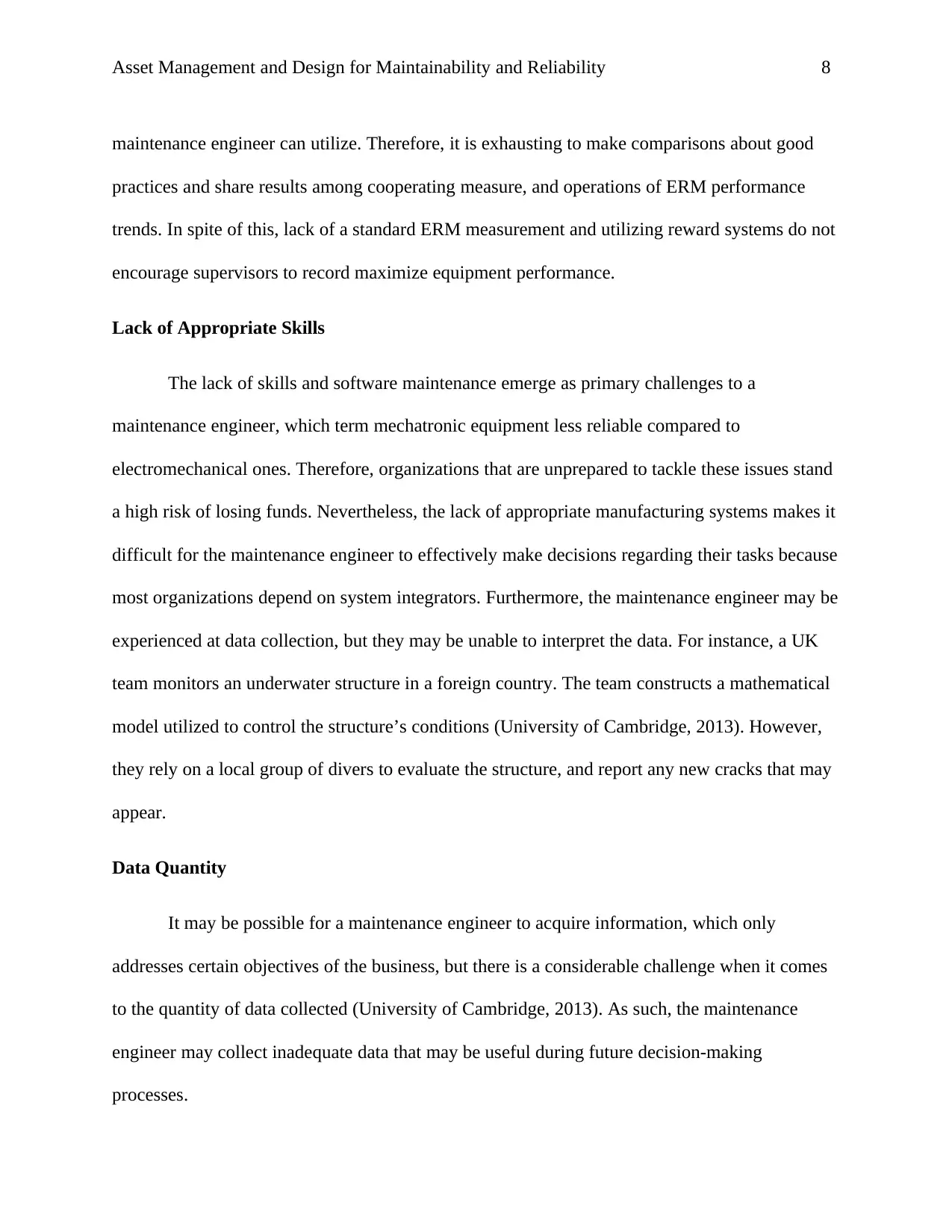
Asset Management and Design for Maintainability and Reliability 8
maintenance engineer can utilize. Therefore, it is exhausting to make comparisons about good
practices and share results among cooperating measure, and operations of ERM performance
trends. In spite of this, lack of a standard ERM measurement and utilizing reward systems do not
encourage supervisors to record maximize equipment performance.
Lack of Appropriate Skills
The lack of skills and software maintenance emerge as primary challenges to a
maintenance engineer, which term mechatronic equipment less reliable compared to
electromechanical ones. Therefore, organizations that are unprepared to tackle these issues stand
a high risk of losing funds. Nevertheless, the lack of appropriate manufacturing systems makes it
difficult for the maintenance engineer to effectively make decisions regarding their tasks because
most organizations depend on system integrators. Furthermore, the maintenance engineer may be
experienced at data collection, but they may be unable to interpret the data. For instance, a UK
team monitors an underwater structure in a foreign country. The team constructs a mathematical
model utilized to control the structure’s conditions (University of Cambridge, 2013). However,
they rely on a local group of divers to evaluate the structure, and report any new cracks that may
appear.
Data Quantity
It may be possible for a maintenance engineer to acquire information, which only
addresses certain objectives of the business, but there is a considerable challenge when it comes
to the quantity of data collected (University of Cambridge, 2013). As such, the maintenance
engineer may collect inadequate data that may be useful during future decision-making
processes.
maintenance engineer can utilize. Therefore, it is exhausting to make comparisons about good
practices and share results among cooperating measure, and operations of ERM performance
trends. In spite of this, lack of a standard ERM measurement and utilizing reward systems do not
encourage supervisors to record maximize equipment performance.
Lack of Appropriate Skills
The lack of skills and software maintenance emerge as primary challenges to a
maintenance engineer, which term mechatronic equipment less reliable compared to
electromechanical ones. Therefore, organizations that are unprepared to tackle these issues stand
a high risk of losing funds. Nevertheless, the lack of appropriate manufacturing systems makes it
difficult for the maintenance engineer to effectively make decisions regarding their tasks because
most organizations depend on system integrators. Furthermore, the maintenance engineer may be
experienced at data collection, but they may be unable to interpret the data. For instance, a UK
team monitors an underwater structure in a foreign country. The team constructs a mathematical
model utilized to control the structure’s conditions (University of Cambridge, 2013). However,
they rely on a local group of divers to evaluate the structure, and report any new cracks that may
appear.
Data Quantity
It may be possible for a maintenance engineer to acquire information, which only
addresses certain objectives of the business, but there is a considerable challenge when it comes
to the quantity of data collected (University of Cambridge, 2013). As such, the maintenance
engineer may collect inadequate data that may be useful during future decision-making
processes.
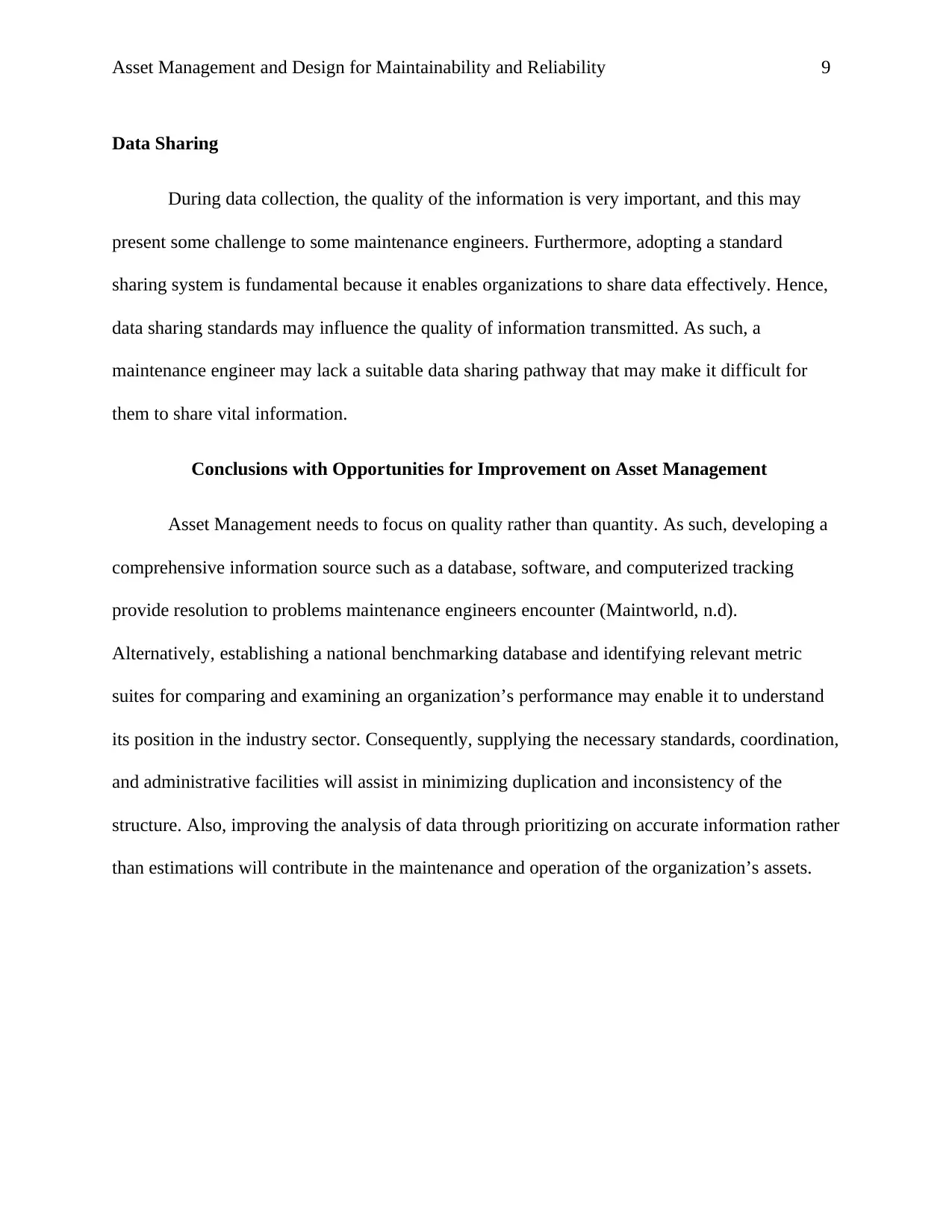
Asset Management and Design for Maintainability and Reliability 9
Data Sharing
During data collection, the quality of the information is very important, and this may
present some challenge to some maintenance engineers. Furthermore, adopting a standard
sharing system is fundamental because it enables organizations to share data effectively. Hence,
data sharing standards may influence the quality of information transmitted. As such, a
maintenance engineer may lack a suitable data sharing pathway that may make it difficult for
them to share vital information.
Conclusions with Opportunities for Improvement on Asset Management
Asset Management needs to focus on quality rather than quantity. As such, developing a
comprehensive information source such as a database, software, and computerized tracking
provide resolution to problems maintenance engineers encounter (Maintworld, n.d).
Alternatively, establishing a national benchmarking database and identifying relevant metric
suites for comparing and examining an organization’s performance may enable it to understand
its position in the industry sector. Consequently, supplying the necessary standards, coordination,
and administrative facilities will assist in minimizing duplication and inconsistency of the
structure. Also, improving the analysis of data through prioritizing on accurate information rather
than estimations will contribute in the maintenance and operation of the organization’s assets.
Data Sharing
During data collection, the quality of the information is very important, and this may
present some challenge to some maintenance engineers. Furthermore, adopting a standard
sharing system is fundamental because it enables organizations to share data effectively. Hence,
data sharing standards may influence the quality of information transmitted. As such, a
maintenance engineer may lack a suitable data sharing pathway that may make it difficult for
them to share vital information.
Conclusions with Opportunities for Improvement on Asset Management
Asset Management needs to focus on quality rather than quantity. As such, developing a
comprehensive information source such as a database, software, and computerized tracking
provide resolution to problems maintenance engineers encounter (Maintworld, n.d).
Alternatively, establishing a national benchmarking database and identifying relevant metric
suites for comparing and examining an organization’s performance may enable it to understand
its position in the industry sector. Consequently, supplying the necessary standards, coordination,
and administrative facilities will assist in minimizing duplication and inconsistency of the
structure. Also, improving the analysis of data through prioritizing on accurate information rather
than estimations will contribute in the maintenance and operation of the organization’s assets.
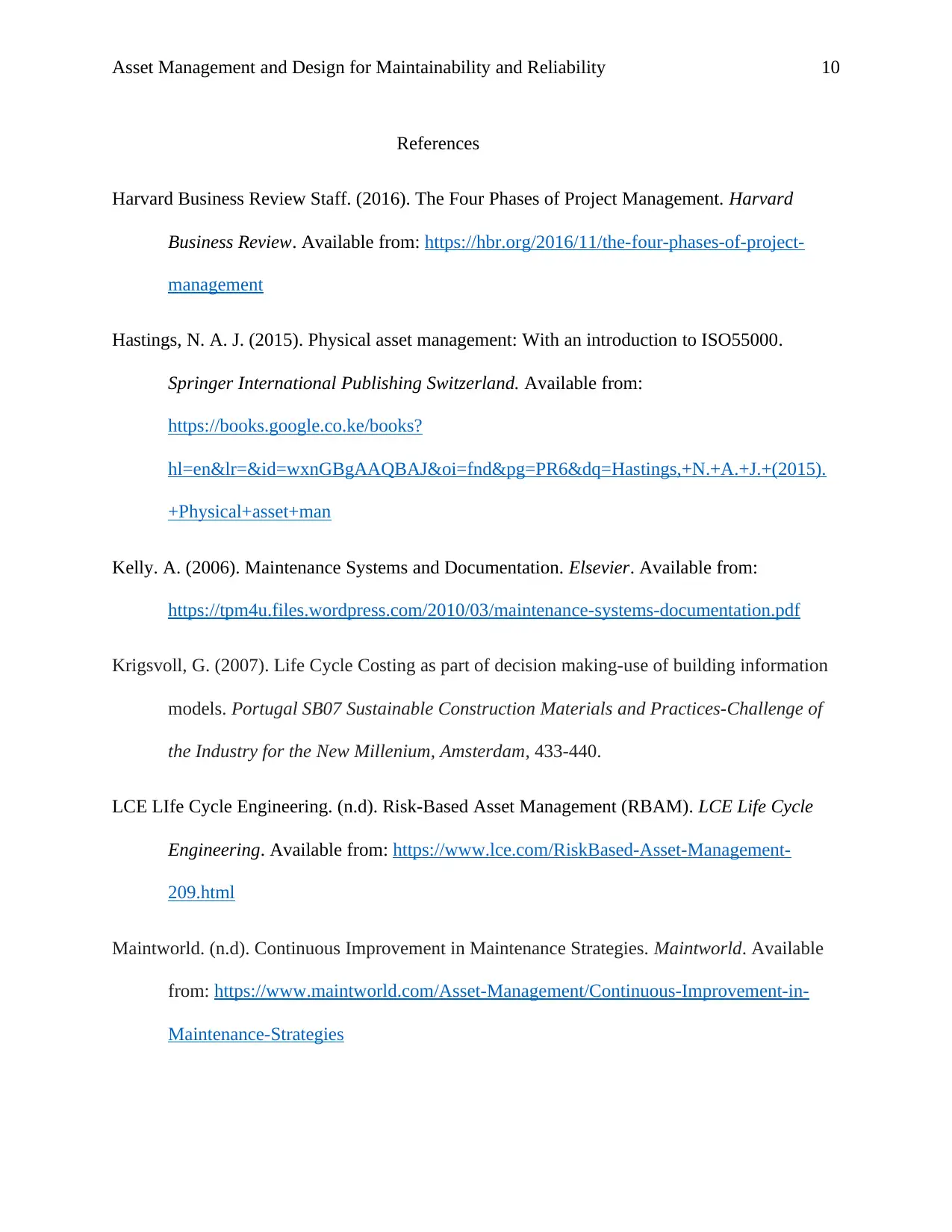
Asset Management and Design for Maintainability and Reliability 10
References
Harvard Business Review Staff. (2016). The Four Phases of Project Management. Harvard
Business Review. Available from: https://hbr.org/2016/11/the-four-phases-of-project-
management
Hastings, N. A. J. (2015). Physical asset management: With an introduction to ISO55000.
Springer International Publishing Switzerland. Available from:
https://books.google.co.ke/books?
hl=en&lr=&id=wxnGBgAAQBAJ&oi=fnd&pg=PR6&dq=Hastings,+N.+A.+J.+(2015).
+Physical+asset+man
Kelly. A. (2006). Maintenance Systems and Documentation. Elsevier. Available from:
https://tpm4u.files.wordpress.com/2010/03/maintenance-systems-documentation.pdf
Krigsvoll, G. (2007). Life Cycle Costing as part of decision making-use of building information
models. Portugal SB07 Sustainable Construction Materials and Practices-Challenge of
the Industry for the New Millenium, Amsterdam, 433-440.
LCE LIfe Cycle Engineering. (n.d). Risk-Based Asset Management (RBAM). LCE Life Cycle
Engineering. Available from: https://www.lce.com/RiskBased-Asset-Management-
209.html
Maintworld. (n.d). Continuous Improvement in Maintenance Strategies. Maintworld. Available
from: https://www.maintworld.com/Asset-Management/Continuous-Improvement-in-
Maintenance-Strategies
References
Harvard Business Review Staff. (2016). The Four Phases of Project Management. Harvard
Business Review. Available from: https://hbr.org/2016/11/the-four-phases-of-project-
management
Hastings, N. A. J. (2015). Physical asset management: With an introduction to ISO55000.
Springer International Publishing Switzerland. Available from:
https://books.google.co.ke/books?
hl=en&lr=&id=wxnGBgAAQBAJ&oi=fnd&pg=PR6&dq=Hastings,+N.+A.+J.+(2015).
+Physical+asset+man
Kelly. A. (2006). Maintenance Systems and Documentation. Elsevier. Available from:
https://tpm4u.files.wordpress.com/2010/03/maintenance-systems-documentation.pdf
Krigsvoll, G. (2007). Life Cycle Costing as part of decision making-use of building information
models. Portugal SB07 Sustainable Construction Materials and Practices-Challenge of
the Industry for the New Millenium, Amsterdam, 433-440.
LCE LIfe Cycle Engineering. (n.d). Risk-Based Asset Management (RBAM). LCE Life Cycle
Engineering. Available from: https://www.lce.com/RiskBased-Asset-Management-
209.html
Maintworld. (n.d). Continuous Improvement in Maintenance Strategies. Maintworld. Available
from: https://www.maintworld.com/Asset-Management/Continuous-Improvement-in-
Maintenance-Strategies
Secure Best Marks with AI Grader
Need help grading? Try our AI Grader for instant feedback on your assignments.
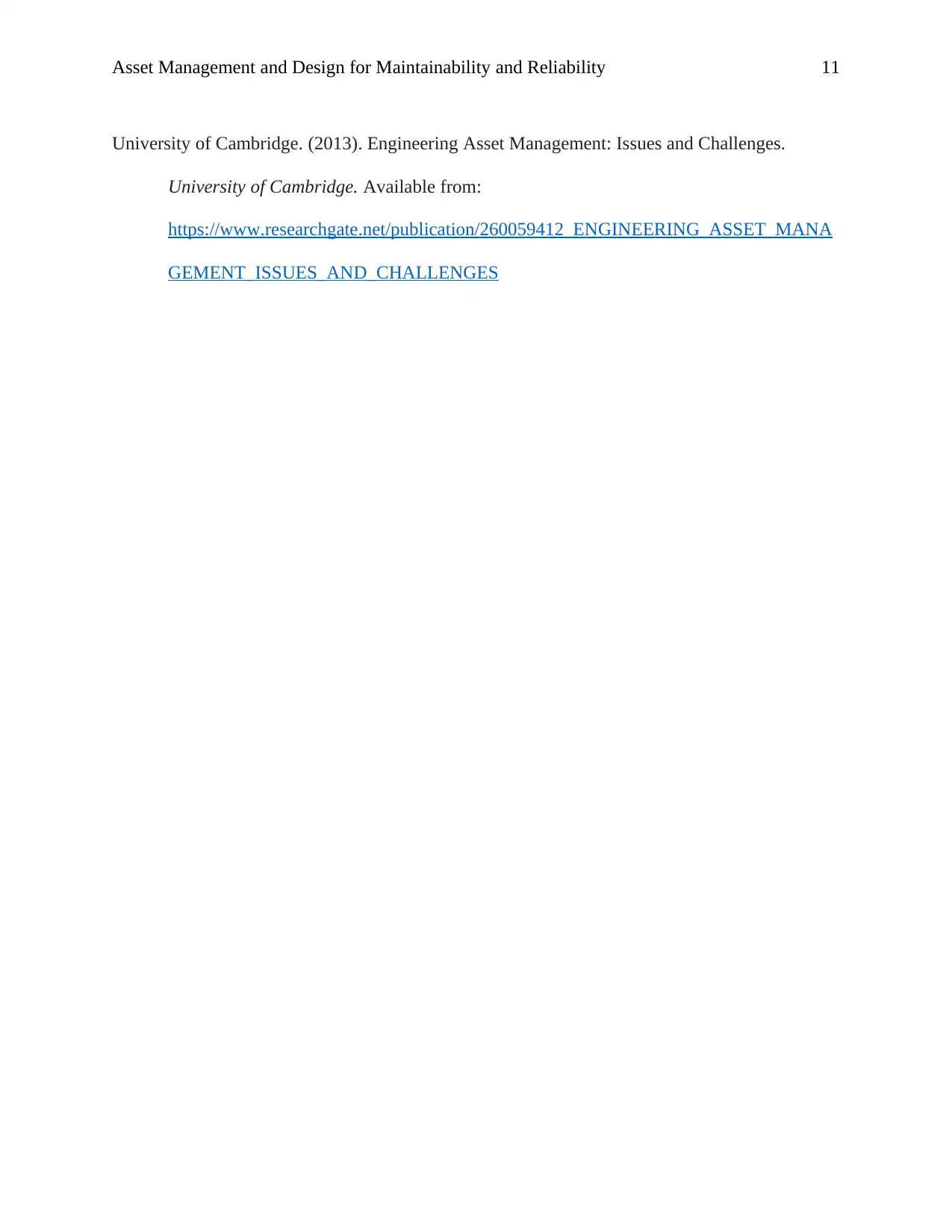
Asset Management and Design for Maintainability and Reliability 11
University of Cambridge. (2013). Engineering Asset Management: Issues and Challenges.
University of Cambridge. Available from:
https://www.researchgate.net/publication/260059412_ENGINEERING_ASSET_MANA
GEMENT_ISSUES_AND_CHALLENGES
University of Cambridge. (2013). Engineering Asset Management: Issues and Challenges.
University of Cambridge. Available from:
https://www.researchgate.net/publication/260059412_ENGINEERING_ASSET_MANA
GEMENT_ISSUES_AND_CHALLENGES
1 out of 11
Related Documents
Your All-in-One AI-Powered Toolkit for Academic Success.
+13062052269
info@desklib.com
Available 24*7 on WhatsApp / Email
![[object Object]](/_next/static/media/star-bottom.7253800d.svg)
Unlock your academic potential
© 2024 | Zucol Services PVT LTD | All rights reserved.





